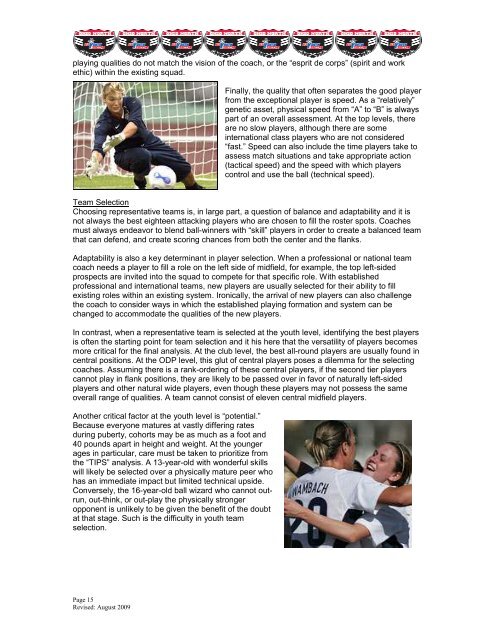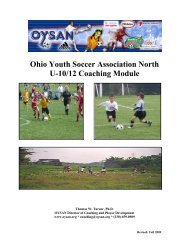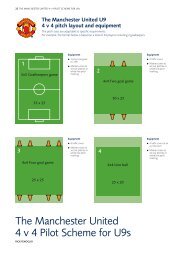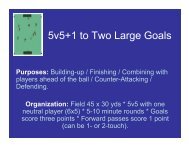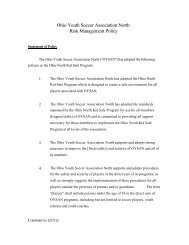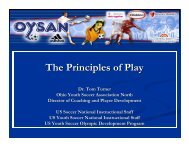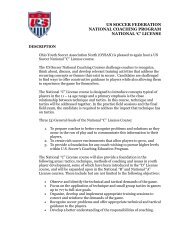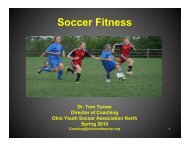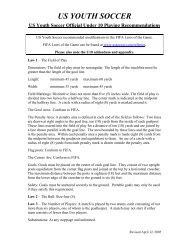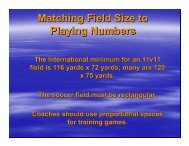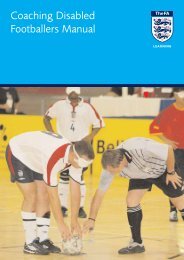What is the US Youth Soccer Olympic Development Program?
What is the US Youth Soccer Olympic Development Program?
What is the US Youth Soccer Olympic Development Program?
You also want an ePaper? Increase the reach of your titles
YUMPU automatically turns print PDFs into web optimized ePapers that Google loves.
playing qualities do not match <strong>the</strong> v<strong>is</strong>ion of <strong>the</strong> coach, or <strong>the</strong> “esprit de corps” (spirit and work<br />
ethic) within <strong>the</strong> ex<strong>is</strong>ting squad.<br />
Finally, <strong>the</strong> quality that often separates <strong>the</strong> good player<br />
from <strong>the</strong> exceptional player <strong>is</strong> speed. As a “relatively”<br />
genetic asset, physical speed from “A” to “B” <strong>is</strong> always<br />
part of an overall assessment. At <strong>the</strong> top levels, <strong>the</strong>re<br />
are no slow players, although <strong>the</strong>re are some<br />
international class players who are not considered<br />
“fast.” Speed can also include <strong>the</strong> time players take to<br />
assess match situations and take appropriate action<br />
(tactical speed) and <strong>the</strong> speed with which players<br />
control and use <strong>the</strong> ball (technical speed).<br />
Team Selection<br />
Choosing representative teams <strong>is</strong>, in large part, a question of balance and adaptability and it <strong>is</strong><br />
not always <strong>the</strong> best eighteen attacking players who are chosen to fill <strong>the</strong> roster spots. Coaches<br />
must always endeavor to blend ball-winners with “skill” players in order to create a balanced team<br />
that can defend, and create scoring chances from both <strong>the</strong> center and <strong>the</strong> flanks.<br />
Adaptability <strong>is</strong> also a key determinant in player selection. When a professional or national team<br />
coach needs a player to fill a role on <strong>the</strong> left side of midfield, for example, <strong>the</strong> top left-sided<br />
prospects are invited into <strong>the</strong> squad to compete for that specific role. With establ<strong>is</strong>hed<br />
professional and international teams, new players are usually selected for <strong>the</strong>ir ability to fill<br />
ex<strong>is</strong>ting roles within an ex<strong>is</strong>ting system. Ironically, <strong>the</strong> arrival of new players can also challenge<br />
<strong>the</strong> coach to consider ways in which <strong>the</strong> establ<strong>is</strong>hed playing formation and system can be<br />
changed to accommodate <strong>the</strong> qualities of <strong>the</strong> new players.<br />
In contrast, when a representative team <strong>is</strong> selected at <strong>the</strong> youth level, identifying <strong>the</strong> best players<br />
<strong>is</strong> often <strong>the</strong> starting point for team selection and it h<strong>is</strong> here that <strong>the</strong> versatility of players becomes<br />
more critical for <strong>the</strong> final analys<strong>is</strong>. At <strong>the</strong> club level, <strong>the</strong> best all-round players are usually found in<br />
central positions. At <strong>the</strong> ODP level, th<strong>is</strong> glut of central players poses a dilemma for <strong>the</strong> selecting<br />
coaches. Assuming <strong>the</strong>re <strong>is</strong> a rank-ordering of <strong>the</strong>se central players, if <strong>the</strong> second tier players<br />
cannot play in flank positions, <strong>the</strong>y are likely to be passed over in favor of naturally left-sided<br />
players and o<strong>the</strong>r natural wide players, even though <strong>the</strong>se players may not possess <strong>the</strong> same<br />
overall range of qualities. A team cannot cons<strong>is</strong>t of eleven central midfield players.<br />
Ano<strong>the</strong>r critical factor at <strong>the</strong> youth level <strong>is</strong> “potential.”<br />
Because everyone matures at vastly differing rates<br />
during puberty, cohorts may be as much as a foot and<br />
40 pounds apart in height and weight. At <strong>the</strong> younger<br />
ages in particular, care must be taken to prioritize from<br />
<strong>the</strong> “TIPS” analys<strong>is</strong>. A 13-year-old with wonderful skills<br />
will likely be selected over a physically mature peer who<br />
has an immediate impact but limited technical upside.<br />
Conversely, <strong>the</strong> 16-year-old ball wizard who cannot outrun,<br />
out-think, or out-play <strong>the</strong> physically stronger<br />
opponent <strong>is</strong> unlikely to be given <strong>the</strong> benefit of <strong>the</strong> doubt<br />
at that stage. Such <strong>is</strong> <strong>the</strong> difficulty in youth team<br />
selection.<br />
Page 15<br />
Rev<strong>is</strong>ed: August 2009


